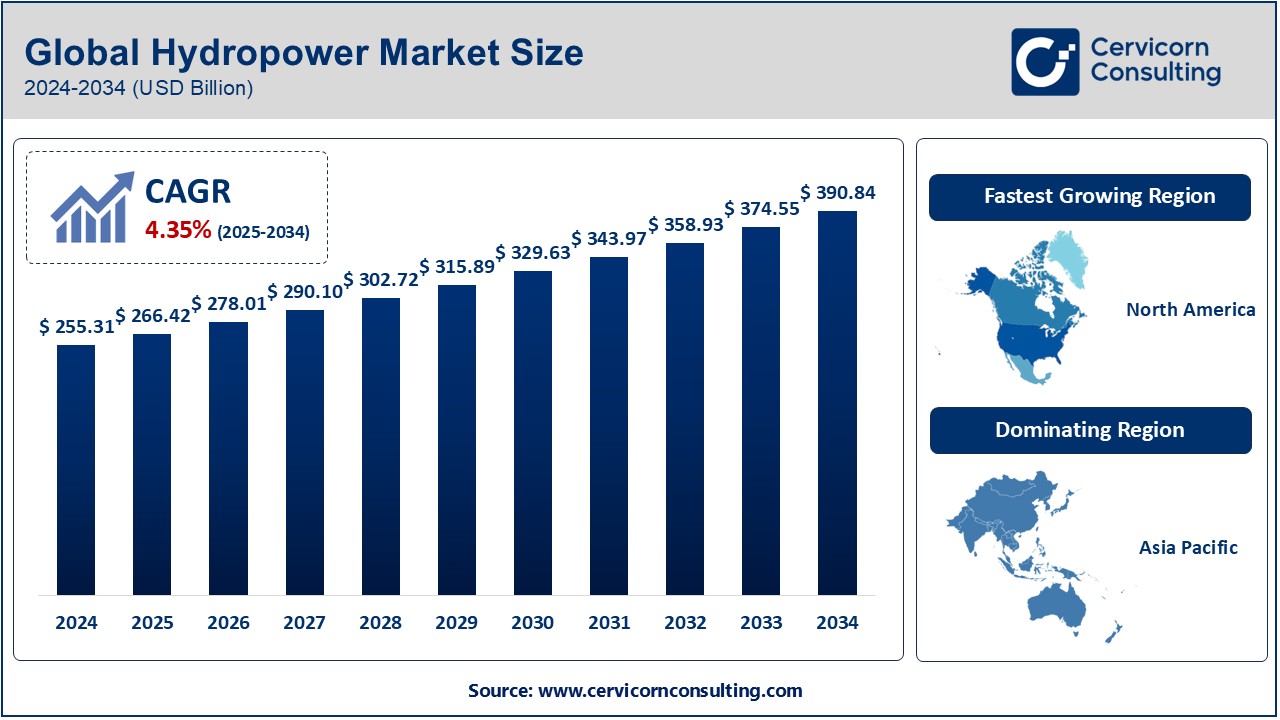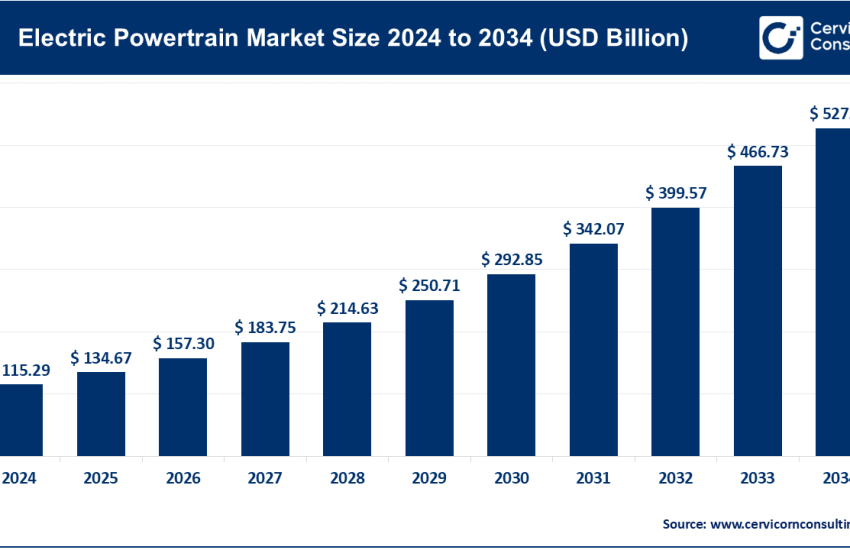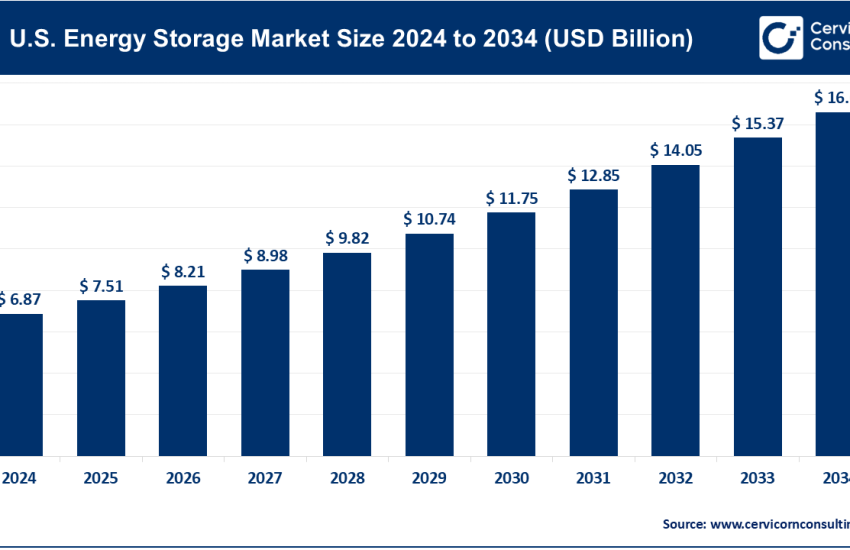Hydropower Market Growth, Trends, Top Companies, and Regional Insights (2025–2034)
Hydropower Market Growth
The global hydropower market was worth USD 255.31 billion in 2024 and is anticipated to expand to around USD 390.84 billion by 2034, registering a compound annual growth rate (CAGR) of 4.35% from 2025 to 2034.
The hydropower market is expanding due to rising global energy demands, increasing investments in renewable energy, favorable government policies, and technological advancements in turbine and generator efficiency. Emerging economies are accelerating the development of large-scale hydropower projects to meet their growing energy needs while reducing dependence on fossil fuels. Environmental concerns and the need for carbon-neutral energy solutions have prompted governments to implement supportive policies, incentives, and subsidies, further driving market growth. Additionally, innovations in pumped storage hydropower systems and the refurbishment of aging infrastructure are enhancing the market’s scalability and reliability.
What is the Hydropower Market?
The hydropower market involves the generation of electricity through the use of water’s kinetic energy. This renewable energy source harnesses flowing or falling water to spin turbines, which in turn activate generators to produce electricity. Hydropower plants can be classified into various categories, including large-scale, small-scale, micro, and pumped storage plants. The market encompasses the manufacturing of turbines, generators, control systems, and the development of infrastructure needed for hydropower facilities. Hydropower plays a critical role in global energy production due to its reliability, scalability, and ability to store energy.
Why is the Hydropower Market Important?
Hydropower is a cornerstone in the transition towards sustainable and renewable energy solutions. It provides a clean, cost-effective, and reliable source of electricity that can significantly reduce greenhouse gas emissions compared to fossil fuel-based energy sources. Additionally, hydropower offers grid stability and storage capabilities, making it a valuable complement to intermittent renewable sources like solar and wind. Hydropower infrastructure can also support water management for irrigation, flood control, and potable water supply, contributing to socio-economic development. As energy demands increase globally, hydropower’s role in providing consistent and eco-friendly energy becomes increasingly vital.
Get a Free Sample: https://www.cervicornconsulting.com/sample/2480
Hydropower Market Top Companies
GE Energy
- Specialization: Hydropower turbines, generators, control systems
- Key Focus Areas: Renewable energy solutions, modernization of existing plants, digital hydropower solutions
- Notable Features: Advanced turbine technology, digital monitoring, and optimization platforms
- 2024 Revenue (Approx.): $18 billion (Renewable energy segment)
- Market Share (Approx.): 8%
- Global Presence: North America, Europe, Asia-Pacific, Latin America
Andritz AG
- Specialization: Hydropower equipment manufacturing, plant services
- Key Focus Areas: Small and large-scale hydropower projects, digitalization
- Notable Features: High-efficiency turbines, automation systems, and plant refurbishment services
- 2024 Revenue (Approx.): $8.5 billion
- Market Share (Approx.): 6%
- Global Presence: Europe, North America, South America, Asia-Pacific
China Three Gorges Corporation
- Specialization: Hydropower plant development, operations, and maintenance
- Key Focus Areas: Large-scale hydropower projects, international project development
- Notable Features: Operator of the world’s largest hydropower station (Three Gorges Dam)
- 2024 Revenue (Approx.): $19 billion
- Market Share (Approx.): 10%
- Global Presence: China, South America, Africa, Southeast Asia
IHI Corporation
- Specialization: Hydro turbines, renewable energy infrastructure
- Key Focus Areas: Technological innovations, clean energy solutions
- Notable Features: Customized turbine solutions, environmental sustainability
- 2024 Revenue (Approx.): $3.5 billion (Energy segment)
- Market Share (Approx.): 2%
- Global Presence: Asia-Pacific, North America, Europe
The Tata Power Company
- Specialization: Power generation, hydropower plants
- Key Focus Areas: Renewable energy expansion, sustainable development
- Notable Features: India’s largest integrated power company with significant hydropower assets
- 2024 Revenue (Approx.): $6 billion
- Market Share (Approx.): 3%
- Global Presence: India, Southeast Asia
Leading Trends and Their Impact
- Technological Advancements: Innovations in turbine design and digital monitoring systems are improving efficiency and reducing operational costs.
- Pumped Storage Development: Growing investment in pumped storage projects is enhancing grid stability and supporting renewable integration.
- Modernization of Aging Infrastructure: Refurbishment and upgrading of existing plants are extending operational lifespans and boosting performance.
- Sustainable Project Development: Eco-friendly project designs are minimizing environmental impact and gaining regulatory approvals.
- Hybrid Energy Systems: Integration of hydropower with solar and wind energy is maximizing renewable energy output and reliability.
These trends collectively enhance the hydropower sector’s competitiveness, sustainability, and ability to meet global energy demands.
Successful Examples of Hydropower Projects
- Three Gorges Dam (China): The world’s largest hydropower station, with a capacity of 22,500 MW, significantly contributes to China’s energy supply.
- Itaipu Dam (Brazil/Paraguay): This binational project generates over 14,000 MW, supporting both countries’ power grids.
- Grand Coulee Dam (USA): One of the largest hydropower facilities in North America, generating approximately 6,800 MW.
- Bhakra Nangal Dam (India): A critical project for irrigation, flood control, and hydropower generation, contributing to India’s power grid.
- Tumut 3 Pumped Storage (Australia): Enhances grid flexibility by integrating hydropower with solar and wind energy.
Regional Analysis: Government Initiatives and Policies
North America
- United States: Federal incentives and investments in hydropower modernization; Department of Energy’s Hydropower Vision initiative.
- Canada: Strong focus on large-scale hydropower development, supported by provincial policies promoting clean energy.
Europe
- EU Policies: European Green Deal and Renewable Energy Directive driving investments in sustainable hydropower projects.
- Norway: Leading hydropower producer in Europe, leveraging abundant water resources and supportive regulations.
Asia-Pacific
- China: Aggressive expansion of hydropower capacity through large-scale projects and international collaborations.
- India: National Hydropower Policy incentivizing small and large hydropower developments to meet renewable energy targets.
Latin America
- Brazil: Major investments in hydroelectric infrastructure, contributing significantly to the national grid.
- Chile: Policy support for renewable energy diversification, including small-scale hydropower.
Middle East & Africa
- Ethiopia: Development of the Grand Ethiopian Renaissance Dam to enhance energy access and economic growth.
- Egypt: Investments in hydropower as part of renewable energy strategies.
To Get Detailed Overview, Contact Us: https://www.cervicornconsulting.com/contact-us
Read Report: Hydrogen Compressor Market Growth, Trends, Top Companies, and Global Insights (2024–2034)



